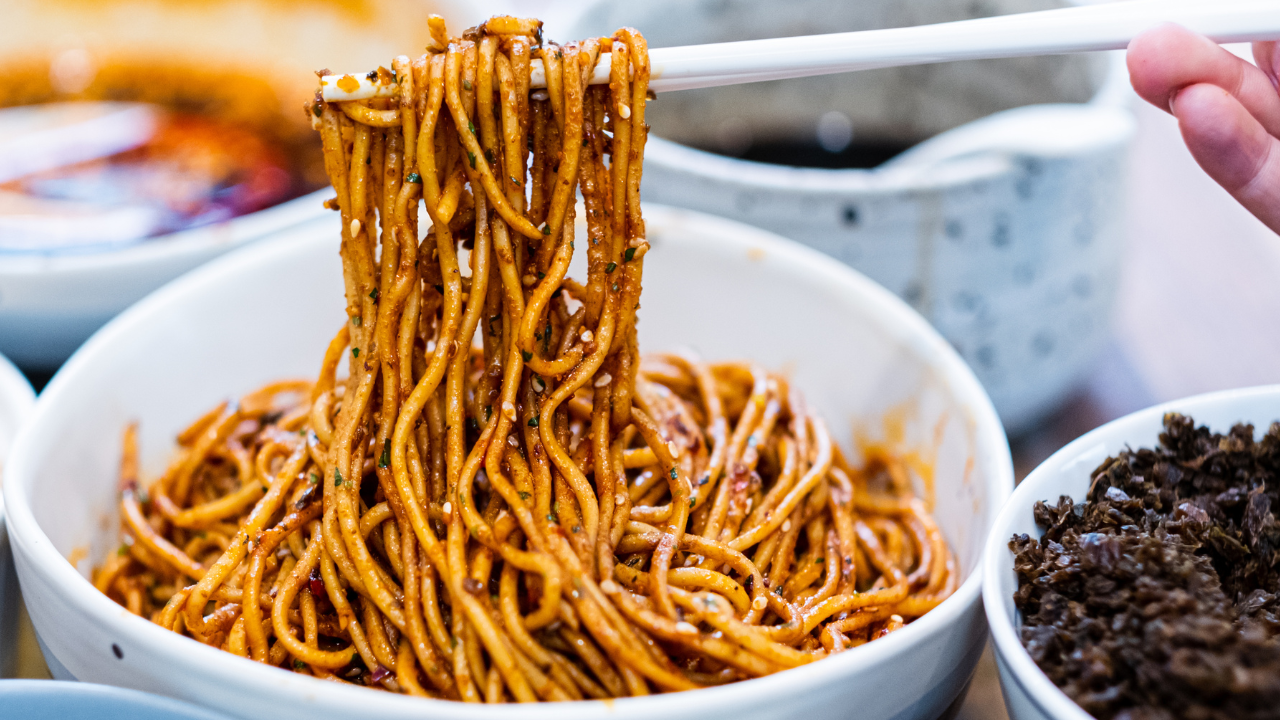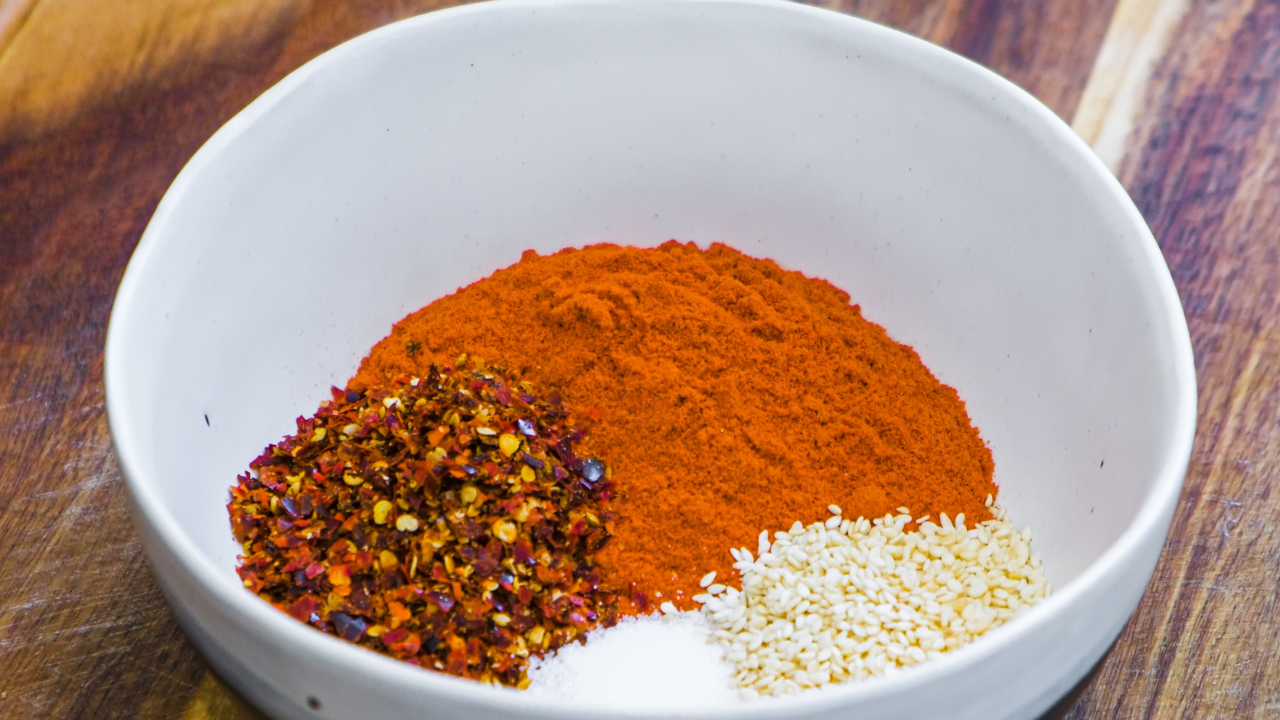Yibin Flaming Noodles: Ignite Your Taste Buds with a Culinary Adventure
Rated 4.0 stars by 16 users
Author:
Souped Up Recipes
Servings
3
Prep Time
1 hour
Cook Time
45 minutes
燃面 [rán miàn] translates as flaming noodles or burning noodles - it sounds spicy, but that is not how it got the name. These noodles are special. In the old days, people would light it up as a wick for kerosene lamps (I tested it, and it works, LOL!).
I think it is the most delicious noodle dish; the texture is nice and chewy. The taste is super flavorful, spicy, and salty. I love the Sui Mi Ya Cai and the roasted nut powder; they make the noodles additively delicious.
It is definitely a worth-trying recipe, but it consists of many different components, which is a bit complicated. Don't worry. I will break them down and go through them one by one as detailed as possible, so you can enjoy these local Chinese noodles in your kitchen.
Replacement Tips
- Sui Mi Ya Cai (碎米芽菜) is preserved and minced mustard green. It has a crunchy texture, a nice fermented flavor, and an umami taste. By the way, if you don't have access to Yacai, you can use some finely diced kimchi or other pickles.
- Alkaline Noodles take a lot of effort to make. If you don't have time, fresh egg noodles or ramen noodles are great replacements.

Ingredients
Make the Noodles (3 servings)
-
300 grams (10.6 oz) of bread flour
-
1/3 tsp of soda ash (碱面)
- 1/2 tsp of salt
- 140 grams (5 oz) of water
-
3-4 tbsp of cornstarch to prevent sticking
Make the Seasoned Sweet Soy Sauce
-
265 grams (1 cup) of light soy sauce
- 240 grams (1 cup) of water
-
71 grams (1/3 cup) of brown sugar
-
1 dried shitake mushroom, cut into small pieces
- 3 slices of ginger
- a shallot, thinly sliced
- 1 scallion
- 4-5 cilantro leaves
-
1 small stick of cinnamon
-
1 piece of bay leave
-
1/2 tsp of fennel seeds
-
1/2 tsp of white pepper
-
1/2 tbsp of Sichuan peppercorn
Make the Sichuan Hot Chili Oil (油泼辣子)
- 280 grams (1.25 cups) of cooking oil
- 1 scallion
- 3 slices of ginger,
- 2 cloves of garlic, sliced thinly
-
2 tsp of Sichuan peppercorn powder
-
1/2 cup of mild chili flake
-
1.5 tbsp of spicy chili flake
-
1.5 tbsp of raw sesame seeds
- 1/2 tsp of salt
-
1 tbsp of Chinese black vinegar
-
2 tbsp of Lithospermum root (Zicao紫草), optional
Make the Roasted Nut Powder
- 40 grams (1/3 cup) of roasted peanut
- 2.5 tbsp of roasted walnut
-
1.5 tbsp of roasted sesame seeds
Make the Garlic Water
- 4 cloves of garlic
- 1/4 cup of water
Make The Sea Weed Soup
-
940ml (4 cups) of chicken stock
- 70 grams (2.5 oz) of bean sprouts
- 6 grams (1/2 cups) of dried seaweed
- 1 tsp of salt
Others:
-
1 package of Yacai (diced pickled mustard green), about 5 oz
- 2-3 scallions, diced
- A bunch of cilantro leaves, diced
Directions
Make The Alkaline Noodles
Ran Main (燃面) uses "Jian Shui Mian 碱水面," which is a type of noodle that contains soda ash. Soda ash is also known as washing soda or sodium carbonate (Na2CO3), which raises the PH level of the dough, and makes the noodles chewier.
- Thoroughly dissolve the soda ash and salt in the waterr. Pour the solution into bread flour and mix until the water is well distributed.
- Knead the dough using a stand mixer for 10 minutes over low speed or by hand for 10 minutes until smooth.
- Divide the dough into three even parts and flatten each piece by hand so they can fit through the pasta roller.
- Start with the thickest setting on the pasta roller and feed the dough through. Once the sheet comes out from the other side or the roller, fold one side of the piece into the middle, then fold the other side over that to form three layers, pressing firmly, and feed the dough through the pasta roller again. Repeat 3-4 times until the dough sheet becomes smooth. Do that to all three pieces of dough.
- Start lowering the thickness and feed the dough sheet through the pasta roller until it reaches your desired thickness.
- Apply a generous amount of cornstarch on the sheet surface to prevent sticking. Next, use a noodle cutter to cut the sheet into noodles. If necessary, coat the noodles with more cornstarch. Cover and set the noodles aside.
Make the Seasoned Sweet Soy Sauce
- Seasoned sweet soy sauce or what we call "Fuzhi Jiangyou 复制酱油," is the prominent flavor of flaming noodles and is used in many Sichuan recipes, such as Zhong's dumplings, mouth-watering chicken, and garlic pork slices. Unfortunely, it is difficult to buy this ingredient outside of China, and I have never find any appropriate replacement, so you have to make it yourself.
- Add all the seasoned sweet soy sauce ingredients to a sauce pot. Bring to a boil, then simmer on low heat without the lid until more than half of the liquid (3/5 of the liquid) is evaporated. This will take 20-30 minutes.
- Sieve and discard the spices. This is more than we need for the flaming noodles; store the extra seasoned sweet soy sauce in a sealed container for up to 6 months at room temperature.
Make the Hot Chili Oil (You Po La Zi 油泼辣子)
- Add Sichuan peppercorn powder, mild chili powder, spicy chili powder, raw sesame seed, salt, and Chinese black vinegar in a big bowl. Mix well and set it aside.
- Add vegetable oil, scallion, ginger slices, garlic slices, cinnamon stick, star anise, and bay leaves in a sauce pot. Heat it over medium heat until the aromatics are nicely charred, which takes 4-6 minutes. Sieve and discard all the aromatics.
- Optionally, put the Lithospermum root (Zicao紫草) on the sieve and quickly swirl it in the hot oil for 20-30 seconds. Lithospermum root has no flavor but will dye the oil into a beautiful purple-red color.
- Use a thermometer to check the oil's temperature. 400°F (204°C) is ideal. If it is too hot, the spices will burn. If it is too low, it won't be able to activate the fragrance.
- Pour the hot oil into the chili flake bowl in batches and stir well. This is more than we need for the flaming noodles; store the extra in a sealed container for up to four months at room temperature or a year in the fridge.
Make the Seaweed Soup
- Flaming noodles are pretty oily and spicy, so traditionally, it is served with seaweed soup.
- Bring 4 cups of chicken stock to a boil. Add bean sprouts and seaweed.
- Season the soup with salt and black pepper to taste.
Prep the Rest of the Components
- To make the nut powder, bake the walnut and peanut in a 350 F oven for 14-16 minutes; bake the sesame seeds in a 350 F oven for 12-14 minutes. Once done, let them cool. Then, blend all the nuts into a rough powder and set it aside. If using roasted nuts, blend them directly.
- Add the Sui Mi Ya Cai into a wok and stir over medium heat for a few minutes or until some moisture evaporates. Set it aside.
- To make the garlic water, press the garlic through a garlic presser. Then mix with 1/4 cup of water and set it aside.
- Dice the scallions and cilantro as fine as possible so they can cling to the noodle strings when you mix everything.
Assemble One Portion of Flaming Noodles
- Cook 1 portion of noodles in boiling water for a couple of minutes or until al dente, which means the center is still firm and chewy.
- Remove the noodles from the water and shake well. This is important because the noodles will reabsorb the moisture and become less chewy.
- Put the noodles into a serving bowl. Add chili oil to taste (I used 3 tbsp), 1.5 tbsp of seasoned sweet soy sauce, 2 tsp of garlic water, 1.5 tbsp of roasted nut powder, some diced cilantro, scallions, and 2 tbsp of Sui Mi Ya Cai and mix well.
- Serve the flaming noodles with the seaweed soup.




















































































